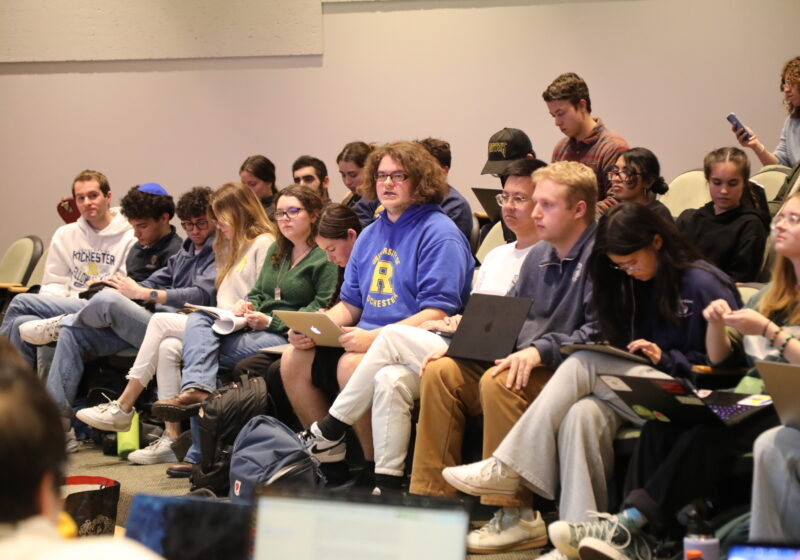Internationally acclaimed violinist Elmar Oliveira performed a show-stopping rendition of the Brahms’ Violin Concerto as he headlined the sixth of the Rochester Philharmonic Orchestra’s 14 part concert series “Philharmonics,” last Thursday and Saturday evenings in the Eastman Theatre.
Conducted by RPO Music Director Christopher Seaman, the concert also featured works by Schubert and Prokofiev.
The program opened with Schubert’s “Rosamunde Overture.” The performance started on an unsettling note. The orchestra seemed a bit unsure of the tempo in the slow introduction and had some trouble settling in.
However, after the transition into the allegro section, this hesitant feeling dissolved and with the increase in confidence came an increase of energy. The orchestra went on to perform the Schubert quite respectably.
Next came Elmar Oliveira’s performance of the Brahms’ Violin Concerto. In the program notes, Seaman describes the work, quite accurately, as “a symphony for violin and orchestra.” A strong performance in the orchestra is just as integral to the success of the piece as is a solid performance in the violin solo. Both the orchestra and Oliveira were up to the challenge.
The concerts in the Philharmonic concert series generally have names that combine both alliteration and an attempt at wit, such as the titles for upcoming concerts “Mad about Mozart,” May 1 and 3, and “Sounds of Spring,” Feb. 13 and 15. This concert was simply titled “Oliveira Plays Brahms.” In theory, the concert was aptly named. Oliveira certainly did play Brahms, but it was much more than that — he owned the piece.
The piece starts out with a lengthy orchestral introduction, and even though the soloist doesn’t come in until a few minutes after the piece begins, Oliveira’s presence onstage could be felt from the orchestra’s starting note. His intensity, even when he was just standing in front of the orchestra was enough to jump-start the RPO into a dynamic beginning.
During the introduction and all of the subsequent orchestral interludes, Oliveira was completely involved in the music. Even when he wasn’t playing, it was as if he was still a part of the piece.
His involvement and interaction with the orchestra made the piece meld into a continuous work — a duet between violin and orchestra, rather than a soloist playing over an accompaniment. In that sort of performer-orchestra dynamic, the piece can truly come alive.
From Oliveira’s first note, he lived up to his dynamic stage presence. He brought a renewed sense of musicality to a piece that has been performed so many times and by so many different soloists.
Admittedly, I entered the concert with a preconceived notion that the Brahms was a ho-hum concerto — pretty, but nothing overly exciting. Oliveira’s performance dismissed such thoughts immediately.
His interpretation was dynamic when it needed to be, but he also knew when to fall back and accompany the orchestra when he didn’t have the melody. There were moments, especially in the second movement, where the interaction between Oliveira and the orchestra was absolutely breathtaking. This was strengthened by the connection that Oliveira took special care to develop with every solo wind instrument and soli string section.
For the most part, the connections were made, and the orchestra fed off of his energy. In a few of the quiet sections, the lower strings could have been more sensitive, especially when there was pizzicato accompaniment, but the mood was lost for no more than a second.
Oliveira was in complete control of the piece. When the orchestra went astray, he was always able to restore the piece’s character.
Oliveira’s playing is unconventional. His extraordinary use of the bow makes use of every last inch in a Perlman-like manner. Though his performance wasn’t perfect — the intonation was a bit on the approximate side in places — it didn’t mar the performance.
Oliveira was commanding and moving throughout the performance. When all was said and done, the title “Oliveira Owns Brahms,” would have suited the performance better. Not to mention, it would have allowed whoever comes up with the names for RPO concerts yet another chance to use alliteration.
Still high on the energy that Oliveira had injected into the orchestra, the RPO performed a rousing rendition of Prokofiev’s Fifth Symphony for the concert’s second half. The orchestra was very successful at maintaining the driving, anxious feeling that is so common in 20th century Russian music present throughout the piece.
This was particularly apparent in the second movement. As in the Schubert, there were a few little glitches in the ensemble and also a noticeable difference in energy level when the orchestra was playing soft compared to any louder dynamic.
All in all, however, the performance was very exciting. The most striking achievement was the way in which the different sections passed the themes between each other. It was almost like a physical motion, as if the audience was watching a musical tennis match.
In his program notes, Seaman wrote, “[the fifth symphony] gives the orchestra a chance to show what they can do.” With a little help from Oliveira, the RPO made Seaman’s promise a reality.


